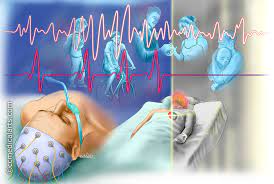When Harry Stamper sets off a bomb to save planet Earth in the film Armageddon, his life flashes before his eyes. Now research has revealed tantalising clues that such recall may not be Hollywood hyperbole.
An international team of scientists has reported an unexpected situation in which they recorded the brain activity of an 87-year-old patient as he died.
The man had been admitted to a hospital emergency department after a fall that resulted in a bleed in the brain, and subsequently deteriorated. When doctors carried out an electroencephalography (EEG), they had discovered the patient had developed epilepsy. However, during the EEG recordings he had experienced a heart attack and died.
The team says analysis of recordings of the 30 seconds before and after the man’s heart stopped beating suggest that in his final moments he experienced changes in different types of brain waves, including alpha and gamma brain waves. The study suggests that interactions between different types of brain wave continue after the blood stops flowing in the brain.
But, the researchers add, it also raises an intriguing possibility. “Given that cross-coupling between alpha and gamma activity is involved in cognitive processes and memory recall in healthy subjects, it is intriguing to speculate that such activity could support a last ‘recall of life’ that may take place in the near-death state,” the team writes in the journal Frontiers in Ageing Neuroscience.
However, the findings are based on the recordings from just one person, and the researchers urge caution, noting among other factors that traumatic brain injuries and white matter damage can affect brain waves, while activity of networks in the brain can be affected by anticonvulsant medication such as that given to the patient.
Nonetheless, the researchers say the results could have important implications.
“These findings challenge our understanding of when exactly life ends and generate important subsequent questions, such as those related to the timing of organ donation,” said Dr Ajmal Zemmar, a neurosurgeon at the University of Louisville, US, and a co-author of the study.
Prof Anil Seth, a neuroscientist at the University of Sussex who was not involved in the research, said the data was “pretty unique”, noting ethically it was not possible to plan the collection of such recordings. But, he added, questions remained.
“The study extends work from about 10 years ago showing characteristic ‘bursts’ of brain activity in rodents prior to death, with some brain activity persisting even after cardiac arrest – especially in the so-called ‘gamma’ frequency range,” he said
“This study, showing similar findings in a dying human, is both moving and fascinating, but whether the recorded activity underlies any particular kind of subjective experience – whether so-called ‘near death experiences’, or impressions of life flashing before ones eyes – is impossible to say, and will likely remain so.”
Dr Steve Taylor, a psychologist at Leeds Beckett University, agreed. “I don’t think we can assume this is a representative example of how the human brain behaves at the point of death,” he said, adding it was also a stretch to link an increase in gamma brain waves with flashbacks before death.
“The life review can actually occur when people are not physiologically close to death – there are many cases of life reviews during falls, for instance,” he said.
 Lebanese Ministry of Information
Lebanese Ministry of Information



